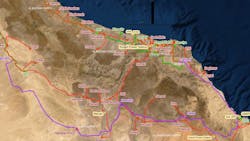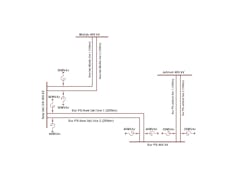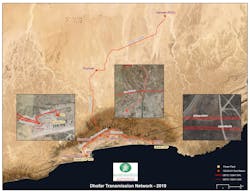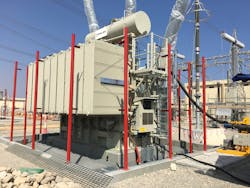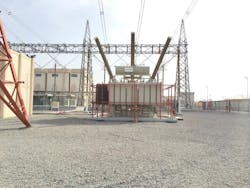Shunt Reactors Installation Improves Transmission System Performance in Oman
The Oman Electricity Transmission Company (OETC) is authorized to undertake all the regulated activities of electricity transmission system and load dispatch in northern and southern Oman. It comprises the Main Interconnected Transmission System (MITS) centered in northern Oman that has three operating voltages i.e. 400 kV, 220 kV and 132 kV and the Dhofar Transmission System (DTS) in southern Oman that has only one operating voltage i.e. 132 kV. The DTS only became under the responsibility of OETC in 2014.
The MITS transmission system comprises some 81 grid stations extending across the whole of northern Oman, interconnecting generators and bulk consumers of electrical energy located in the Governorates of Muscat, Batinah South, Batinah North, Dhahirah, Buraimi, Dakhliyah, Sharquiya South and Sharqiya North. The MITS overhead line transmission system is 6443.65 km (4003.9 miles) in length.
The Dhofar Transmission System (DTS) in southern Oman based in the Dhofar Governorate, is a much smaller transmission system operator having eight grid stations and a 132 kV overhead transmission line network 501.8 km (311.8 miles) in length. At present, there is no electrical interconnection between the MITS and DTS transmission systems.
System Development
The OETC transmission systems are subject to widespread and rapid development due to the expansion and rapid load growth of the distribution companies and large power private customers. Therefore, new generation facilities and further reinforcement of the MITS and DTS transmission systems are required in order to supply the annual growth in the peak demand. For example, in the past decade the recorded peak demand on the MITS has increased from 2232 MW to 6335 MW (284%) and on the DTS from 178.3 MW to 567 MW (318%). To meet future demands and satisfy the Transmission Security Standards there is a major programme of capital investment on both transmission systems to improve the transmission system performance in northern and southern Oman
Environmental Conditions in Oman
The maximum demand on the MITS and DTS transmission systems usually occurs during the period of highest temperatures, namely, May to July caused by the air conditioning equipment that is installed in commercial premises and domestic dwellings. The peak demand is usually recorded in the afternoon when the temperatures are at their highest. Conversely, the minimum demand on these transmission systems occurs during January.
To meet the wide-scale differences in maximum and minimum demand that in 2018 for the MITS it was 6335 MW (maximum) and 1532 MW (minimum) and the DTS, 567 MW (maximum) and 115.2 MW (minimum), the highest summer system availability has to be planned in advance e.g. in excess of 99%. Hence, there is no planned maintenance during May to July.
The MITS 400 kV Transmission System
Oman’s first section of the 400 kV transmission system was erected by the OETC to interconnect the large gas-fired power plant at Sur (2000 MW) in northern Oman to the MITS. One of the 400kV, 250 km (155 mile) double-circuit overhead lines was used to supply energy to the 400 kV New Izki Grid Substation. Additionally the, OETC has constructed 100 km (62 miles) 400kV double-circuit overhead lines between Sur PS and Jahloot; between Ibri and the New Izki Grid Substation (264 km-164 miles) and Sohar Free Zone and the Sohar Interconnection Substation (34 km- 21 miles). Furthermore, a one 400kV 100 km (62 miles) double-circuit overhead line between the New Izki Grid Substation and Misfah will be commissioned in 2020.
Load flow studies undertaken during the design stage confirmed that the voltage levels at some of the MITS Grid Substations stations could reach high values which exceeded the Transmission Security Standard (± 5% at 400kV) during periods of off-peak demand. This being caused by the reactive power generated by 400 kV lines. Moreover, the voltage at a number of Grid Substations reached values in excess of 12.75% at 400 kV and 10.6% at 220 kV during the off-peak demand period. These excessively high values can even lead to difficulties in synchronizing the 400 kV transmission lines.
Furthermore, due to light loading of the 400kV long overhead transmission lines supplying the New Izki Grid Substation the nominal voltage at 220 kV was exceeded by 10% and the voltage at 400 kV end of the transmission line was 1.116 p.u. and 1.128 p.u. at Sur Power Plant and New Izki Grid Substation respectively.
OETC’s Solution
As quality of supply is measured in terms of system voltage and frequency it was important for OETC to find the optimum solution so consideration was given to three different options.
The first option was to install fixed shunt reactors directly connected to the 400kV overhead lines starting with the New Izki Grid Substation that has 400 kV double-circuit lines to the Sur Power Plant and Misfah, from the Sur Power Plant to the New Izki Grid Substation and Jahloot, a total 290 MVAr installed in the following positions on the MITS:
2 x 40 MVAr shunt reactors at each end of the 400 kV circuits between the New Izki Grid Substation and the Sur Power Plant.
2 x 30 MVAr shunt reactors installed at the New Izki Grid Substation end of 400 kV circuit to Misfah.
2 x 35 MVAr shunt reactors installed at the Sur Power Plant end of the 400 kV circuit to Jahloot.
The second option was to install fixed shunt reactors in New Izki Grid Substation and Sur Power Plant connected to both busbars by 400 kV GIS bays in total 360 MVAr i.e. (2 x 90 MVAr at the New Izki Grid substation and 2 x 90 MVAr at Sur Power Plant).
Finally, the third option was to install mechanically switched compensators (MSC) or static VAr compensators (SVC) in the New Izki Grid Station. OETC decided that option one namely, the installation of fixed 400 kV shunt reactors at the Sur Power Plant and the New Izki Grid Station directly connected to the 400 kV double-circuit overhead lines offered the best solution as it was the cheapest option achieving the resolution of all voltage problems.
Installation of the 400 kV Shunt Reactors
The shunt reactors were installed with circuit breakers that offered the flexibility of disconnection during the periods of maximum demand. Installation of the all shunt reactors at the Sur Power Plant, the New Izki Grid Substation and at MIsfah and Jahloot were all subject to separate contracts. The installation and commissioning of all the shunt reactors was completed in April 2018 at a total cost of R.O. 8.34 million (US$ 21.68 million). The manufacturer of all the shunt reactors was the Dutch Company, Royal Smith.
Furthermore, since the completion of this project OETC recently installed 4 x 100MVAr shunt reactors at each end of the 400 kV overhead lines between the New Izki Grid Substation and Ibri.
The installation of the shunt reactors has improved the system performance by decreasing the short-circuit levels and the generator regimes by slightly reducing the reactive power output. Following, the installation of these 400 kV shunt reactors, the system voltage on the MITS transmission system during the off-peak load period has been maintained within the acceptable limits.
About the Author
Hisham Abdullah Al Riyami
Hisham Abdulla AL Riyami is currently holding the position of network planning manager at OETC, deputy chairman of Grid Code Review Panel and member in the planning committee of GCCIA. He previously served OETC as head of the strategic planning & studies section (2013-2015) and system studies engineer (2008-2013). Riyami who has B.Sc. Eng. in Power Systems and Energy from the Sultan Qaboos University, Oman in 2008 has published more than 45 technical papers and he is a Senior Member in the IEEE.
Ahmed Ali Al-Nadabi
Ahmed Ali AL-Nadabi has an Electrical Power Degree from Sultan Qaboon University and a M. Sc. in Electrical Energy Systems from Cardiff University. He joined OETC as a planning engineer, then a senior planning engineer and currently he is the regulatory and compliance manager. He has been involved in many strategic projects such as Transmission Master Plan 2014-2030, Interconnections with neighboring countries and many studies for generation and bulk load connection projects. AL Nadabi has published around 30 technical papers.
Aiman Rashid Al-Naamani
Aman Rashid AL Naamani has B.Sc. in Power Systems and Energy from the Electrical and Computer Department, Sultan Qaboos University, in Oman. As a system planning engineer at OETC he has been involved in strategic studies such as updating OETC’s Five Year Annual Transmission Capability Statement and studies for generation and direct connection loads AL Naamani is also a member in the IEEE.
Ahmed Sulaiyam Al-Omairi
Ahmed Sulaiyam Al-Omairi has Electrical Power Degree from Higher College of Technology (HCT )is a system studies engineer joining at OETC in 2014. His work includes many studies related to OETC system such as updating OETC’s Five Year Annual Capability Statement (5YACS) using the DigSilent PowerFactory Program and he has been involved in many projects linked to generation and direct connection loads. AL Omairi who is a Member in the IEEE has published a number of technical papers.
